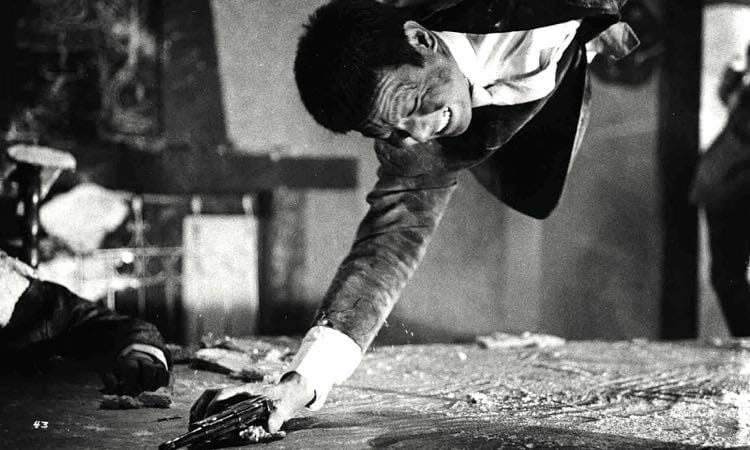By Matthew Pizana · October 28, 2014

Seijun Suzuki had already made several dozen films in the Japanese studio system by the time he began work on Youth of the Beast in 1963. Many of the films coming out of the Japanese studios at the time were boiler plate basic, meaning a simple plot for the audience to follow and digest but very little in the way of originality. Youth of the Beast bursts out of this old model catapulting Seijun Suzuki’s career into one of the most unique and original voices in cinematic history.
Youth of the Beast centers around Jo (Jo Shishido) an officer who has spent the last few years in prison for corruption charges that may or may not have been trumped up. Now a free man, he sets out to uncover how his former partner was found dead in bed with a prostitute. The police have ruled it a suicide. Jo sees it as a setup and a murder.
Jo first appears in the story single-handedly beating up a group of street thugs. This draws the attention of a local crime syndicate who invites Jo in to speak with the bosses. Jo takes the opportunity to offer his services to the clan in order to help take down their rival gang. With his offer accepted, Jo sets about knocking off the competition. His efforts last for only a short while before the Nomoto gang brings Jo in to meet with their own boss. Jo presents this second boss with the same offer as the first, to spy on the rival gang, placing himself front and center in the middle of a yakuza war. Now, playing a dangerous game of being on both sides of the fence, Jo has to put the pieces together of what happened to his partner and figure out who set the whole thing in motion before he is killed in the process.
Like Charles Bronson in Death Wish, Lee Marvin in Point Blank, or any movie that Denzel Washington seeks revenge, Jo is an antihero on a mission to dole out punishment to those that have wronged him no matter his personal cost. Jo taunts an enforcer for one of the gangs almost getting his face sliced open like a set of venetian blinds in the process. During a different encounter with the yakuza, Jo nearly loses a finger while being tortured before he can finally convince them that he no longer works for the police. It’s almost as if Jo doesn’t mind living on the wrong side of life and death situations he continues to find himself involved in.
Despite the violence, drugs and unadulterated sadomasochism that is the calling card of Suzuki’s vision of the underworld, Youth of the Beast rides a terrifically wonderful sense of humor throughout. During Jo’s first meeting with the yakuza, he yanks a boss's jacket sleeve out of his pocket assuming the boss has a gun trained on him. In reality, the boss actually only has one arm. A flame thrower is made from hairspray and a lighter and used as a means of intimidation during a shakedown. Even at the height of a robbery, a fake bomb is used with great pleasure and amusement to the party not being robbed.
The first in a trio of yakuza crime films made by Seijun Suzuki, Youth of the Beast is a master director beginning to find his voice on screen. Suzuki’s next two movies led him even further away from the vision the studios had for a film culminating in Branded to Kill being labeled so “incomprehensible” by the studio that they barred the director from making films for the next decade. Seijun Suzuki wore this as a badge of honor never wavering from his vision as an artist placing himself on the list of all time great visionary directors.
https://youtube.com/watch?v=pk6H4r7FfVI%26nbsp%3B